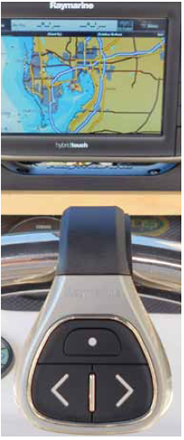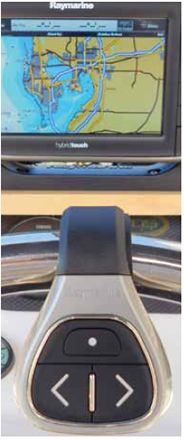
184
Raymarine has re-defined onboard interface with WiFi and Bluetooth capabilities in its new MFDs. Using an iPad or iPhone (Version 4 or newer), a Kindle Fire Tablet, or any Android Smartphone or Tablet, users can stream the e7D display to these devices using the RayView free app downloadable from iTunes, Amazon, or the Google Play Android store. This allows you to use these devices as a second display.
We tested the Bluetooth interface with the battery-powered (4 AAAA) Raymarine RCU-3 remote ($135). The unit clamps onto the helm where it is finger-tip accessible or can be worn around the neck on a lanyard. This is a context-driven device, allowing you to zoom charts, change depth ranges on the sounder, control music volume, and change pages without your hands leaving the helm. You can also customize the remote for specific tasks. The RCU-3 was easy to set up and use, but the battery compartment proved a bit difficult to close.
Two new wireless apps, RayRemote ($30) and RayControl ($50) allow for full two-way control of the e7. RayRemote, designed for smartphones, includes a screen viewer, as well as a full function WiFi remote controller. All of the keys and controls, including the Unicontroller, are available on the RayRemote app.
RayControl offers touchscreen control of the the e7D from any 7-inch or larger Apple iPad or Android Tablet. The live image from the MFD is presented on the tablet, and you can touch and control the e7D on the tablet, exactly as If you were working on the actual e7D. In addition to the touch interface, there is a virtual slide-out keypad that mimics the e7D’s keypad and unicontroller.
The Bluetooth interface also lets you manage media streaming from a Bluetooth-enabled device or one with a Bluetooth adapter.







































